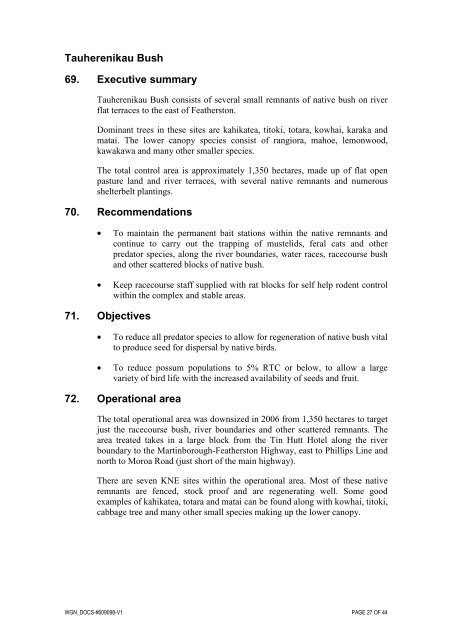Wairarapa Key Native Ecosystem Management Areas - Greater ...
Wairarapa Key Native Ecosystem Management Areas - Greater ...
Wairarapa Key Native Ecosystem Management Areas - Greater ...
You also want an ePaper? Increase the reach of your titles
YUMPU automatically turns print PDFs into web optimized ePapers that Google loves.
Tauherenikau Bush<br />
69. Executive summary<br />
Tauherenikau Bush consists of several small remnants of native bush on river<br />
flat terraces to the east of Featherston.<br />
Dominant trees in these sites are kahikatea, titoki, totara, kowhai, karaka and<br />
matai. The lower canopy species consist of rangiora, mahoe, lemonwood,<br />
kawakawa and many other smaller species.<br />
The total control area is approximately 1,350 hectares, made up of flat open<br />
pasture land and river terraces, with several native remnants and numerous<br />
shelterbelt plantings.<br />
70. Recommendations<br />
• To maintain the permanent bait stations within the native remnants and<br />
continue to carry out the trapping of mustelids, feral cats and other<br />
predator species, along the river boundaries, water races, racecourse bush<br />
and other scattered blocks of native bush.<br />
• Keep racecourse staff supplied with rat blocks for self help rodent control<br />
within the complex and stable areas.<br />
71. Objectives<br />
• To reduce all predator species to allow for regeneration of native bush vital<br />
to produce seed for dispersal by native birds.<br />
• To reduce possum populations to 5% RTC or below, to allow a large<br />
variety of bird life with the increased availability of seeds and fruit.<br />
72. Operational area<br />
The total operational area was downsized in 2006 from 1,350 hectares to target<br />
just the racecourse bush, river boundaries and other scattered remnants. The<br />
area treated takes in a large block from the Tin Hutt Hotel along the river<br />
boundary to the Martinborough-Featherston Highway, east to Phillips Line and<br />
north to Moroa Road (just short of the main highway).<br />
There are seven KNE sites within the operational area. Most of these native<br />
remnants are fenced, stock proof and are regenerating well. Some good<br />
examples of kahikatea, totara and matai can be found along with kowhai, titoki,<br />
cabbage tree and many other small species making up the lower canopy.<br />
WGN_DOCS-#609098-V1 PAGE 27 OF 44
















